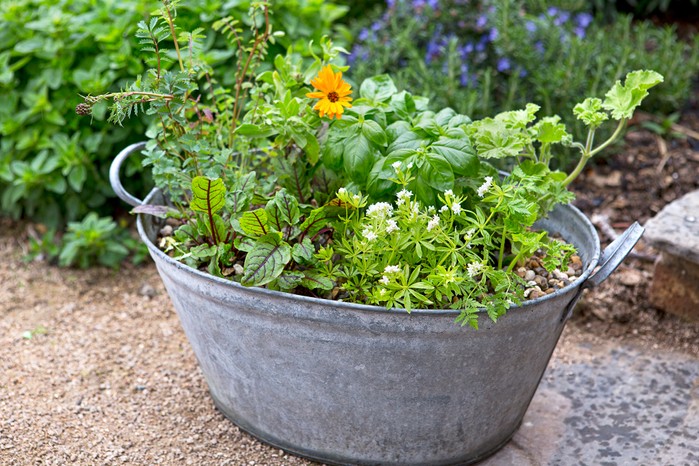
Sweet woodruff (Galium odoratum) is a mat-forming, perennial plant that makes good-looking ground cover for shade in both formal and wilder gardens. It produces a pretty mass of tiny scented white flowers in early summer that are a good source of nectar for bees and other pollinators. In the UK it goes dormant over winter, and all its leaves die back. Fresh new leaves grow in spring and stay lush and green until late autumn.
Another name for sweet woodruff is sweet-scented bedstraw, a hint that the strong fragrance of the dried plant was traditionally used to mask bad smells indoors. It’s also called wild baby’s breath and, in Germany, Waldmeister, which means master of the woods.
Sweet woodruff’s is edible and is therefore not toxic to animals or humans. You can use the sweet flowers as a garnish and the leaves in salads. When picked young and eaten fresh, the leaves have a very mild flavour. However, when dried they develop a strong taste of hay and vanilla (the drying process has to be quick and the leaves must be stored in an airtight container, otherwise they may undergo chemical changes that make them harmful). Long valued as an herbal medicine or tea, sweet woodruff has also been used in cheesemaking (as it is curdles the milk) and to add a mild vanilla flavour to other foods, including salads, jellies and beer.
How to grow sweet woodruff
Grow low-growing sweet woodruff in full or dappled shade, under shrubs or as an edging plant for a shady border.
Where to grow sweet woodruff
Sweet woodruff growing in a pot with other herbs
Sweet woodruff grows naturally in damp European woodlands, including the UK, especially in chalky areas. In the garden it grows best in moist but well-drained soil in partial or full shade, though it will tolerate dry shade. This means it works well in a mixed border, or under shrubs and trees, growing to around 20cm tall. The dark green narrow leaves grow in whorls along its slender stems, forming dense carpets that act as a living mulch, shading out weeds and slowing the evaporation of water from the soil surface. It may not thrive in highly acidic soils.
Plant sweet woodruff in full or dappled shade, under shrubs or as an edging plant for a shady border.
How to plant sweet woodruff
Use a trowel to dig a generous hole (taking care not to damage the roots of nearby shrubs), backfill around the plant, firm it in with your fingers and give it a good water. If you have more than one plant, space them about 25cm apart. Keep your woodruff watered until it is established. Otherwise, it needs very little attention.
More like this
How to care for sweet woodruff

Watering sweet woodruff
In spring, give your sweet woodruff patch a light rake to remove remaining plant material from the previous year. Otherwise, it needs very little attention. It will grow through any mulch you put on your shady border or around your shrubs. The mulch will help to conserve moisture in the soil, providing the damp conditions in which sweet woodruff thrives.
Is sweet woodruff invasive?

Sweet woodruff growing in a border
In the right conditions sweet woodruff can be quite vigorous, spreading via shallow roots running just below the soil surface. However, it’s not invasive – if it spreads into unwanted areas, it’s straightforward to remove it. Use a spade to cut vertically through the roots at the point where you want to limit it, dig up the excess plant and dispose of it (or pot it up and give it to a friend).
Propagating sweet woodruff
Sweet woodruff can be propagated by dividing established clumps in autumn or spring and transplanting them. It is also easy to grow from seed. Lightly rake over the area where you’d like it to grow, scatter the seed lightly and water using a watering can with a rose to avoid washing the seeds away. Sow from February to May or in early autumn.
Pests and diseases
Sweet woodruff is generally pest and disease free.
Advice on buying sweet woodruff
- Look for compact plants with multiple stems and deep green leaves
- As sweet woodruff is a fast spreader, you don’t need to invest in large plants
- Always check plants for signs of damage or disease, before planting
